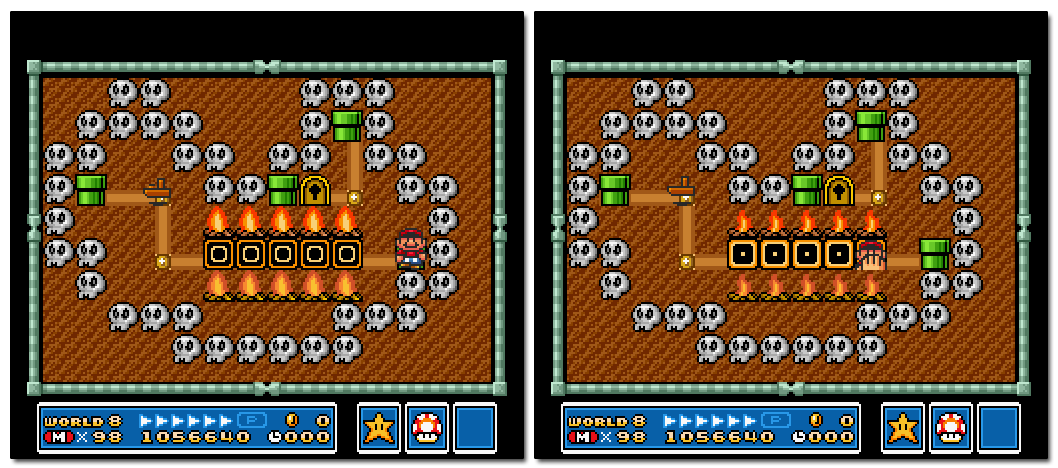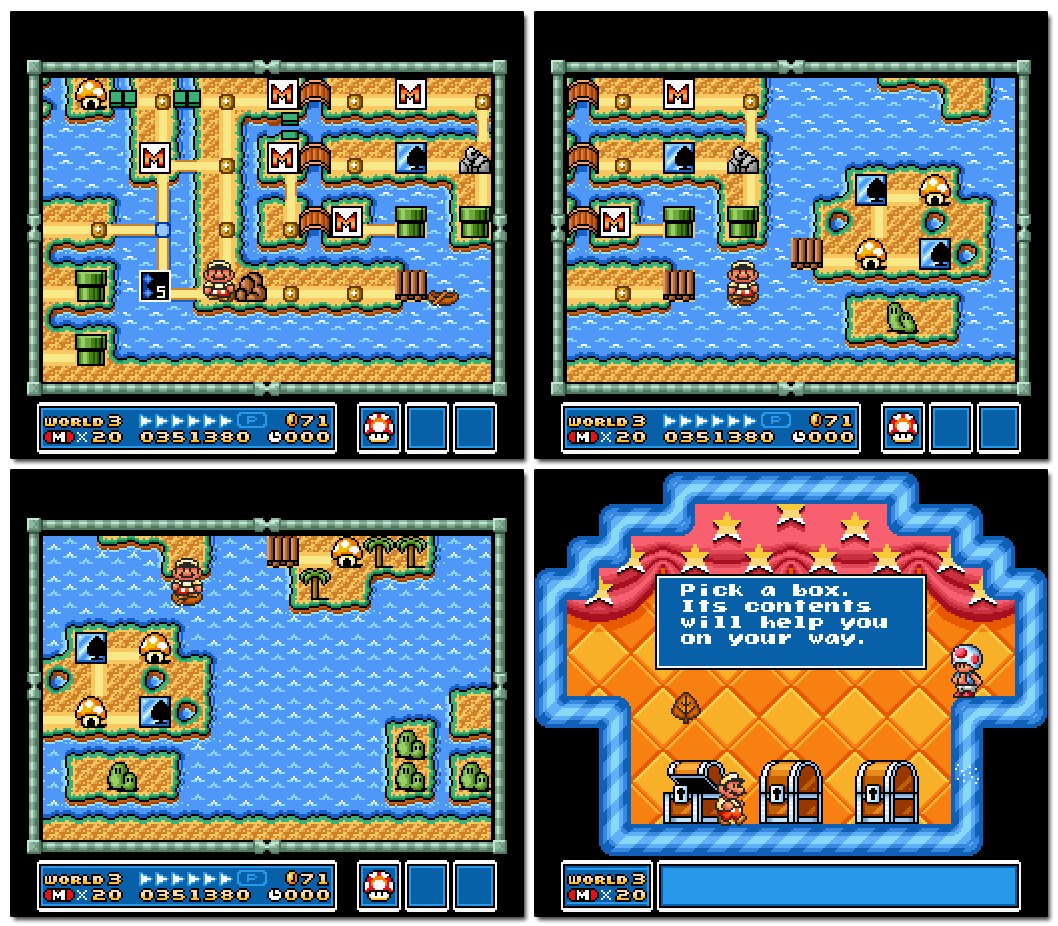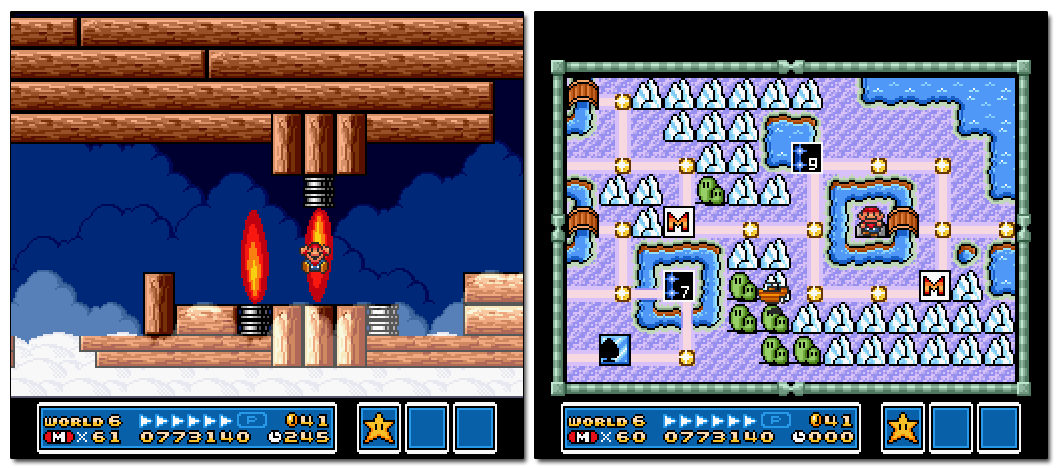Introduction
For my second SMB 3 post, I took a look at worlds 2 through 8 and picked out 30 stages that exemplified clever level design. World 8 is the last standard zone in the game, but I decided to write one more article detailing SMB 3’s hubs.

Hubs are an old videogame trope, but in SMB 3 they are much more involved than in previous incarnations.
Each hub in the game has its own visual theme and unique layout, e.g., World 7 is a scrolling archipelago, while World 8 comprises multiple skull-filled maps. These areas are not only littered with standard level nodes, but also contain unique stage-icons such as quicksand pits, tanks, and piranha plants. Offsetting these challenges are shops and sporadic minigames that provide bonus rewards.
All these elements — and plenty of additional ones — turn the overworlds into individual mini-levels that are also connected to the main gameplay stages. Here are 10 examples of how that’s done:
1. Pipeline Shortcuts

Entering pipes on the hub transports Mario to tiny, single-screen levels. These levels contain no enemies and simply serve to ferry Mario from one point on the overworld to another. The game could’ve simply teleported Mario on the hub and avoided this element altogether, but it accents the link between the hubs and the main gameplay stages. It also serves to cement an internal logic that pipes are gateways anywhere in Mario’s universe.
In addition, pipe detours can facilitate alternate routes through the hubs, allowing the player to skip entire batches of levels. This approach of making stages optional is something that became more and more prevalent in each Mario sequel. The notable point here is that it allows the designers to isolate the more challenging levels so that fewer players ever get stuck.
2. Wandering Enemies
Adding a bit of life to the hubs are various types of Hammer Bros. that move around non-level nodes whenever the player exits a stage (by either completing it or dying). Stepping on a node occupied by Hammer Bros. teleports Mario to a single-screen arena where a battle ensues.
Defeating the Hammer Bros. yields a random powerup from a set different than that of the stores, e.g., the player can receive a Starman or a Hammer.
The Music Box powerup can also put all the Hammer Bros. to sleep, allowing the player to safely pass across the nodes they occupy.
3. Fortress Destruction
Beating the mini-boss Boom Boom releases a “?” Ball that, when touched, destroys his home. This is a nice connection to the hub itself as the fortress blows up when Mario exits the level, clearly linking the two events. This is the only way to get past a Fortress Node as it’s not possible to fly over it with Lakitu’s Cloud.
This sort of hub-updating is common to completing non-standard levels, e.g., blocking doors are removed and bridges are lowered to allow passage.
4. Hand Traps
Hand Traps are special nodes located in just a single part of World 8. They can randomly drag the player into a level whenever he walks over them, adding variety to the overworld’s mechanics. This event is accompanied by an animation of a large hand pulling Mario down, further emphasizing the link between the hubs and the stages.
5. Bonus Toad Houses
Collecting all the coins in certain levels unlocks a special blue (white in the original) Toad House on the hub. Unlike the standard houses, these only contain a single chest that yields either a P-Wing or an Anchor.
Aside from providing an optional challenge and an extra reward, the bonus houses are another great link between the core stages and the overworlds.
6. Destructible Obstacles
Various hubs contain rocks that the player can destroy using a hammer. These usually open up a path to an extra reward or serve as shortcuts that allow the player to skip some levels.
This sort of interaction with the environment prevents the hubs from feeling static, and World 2 actually uses the mechanic to hide a secret!
If the player uses the hammer in the top-right corner of the map, he’ll open up an additional path to a Hammer Bros. duo that drops a Warp Whistle. There’s no obvious hint of this secret as there are plenty of rocks in the level and the map doesn’t scroll to reveal the path until the rock is destroyed. Despite this, it’s a very satisfying secret to discover with an equally worthwhile reward.
7. The Canoe
World 3 allows Mario to hop in a canoe as an alternative mode of transportation. The canoe moves gradually instead of jumping from node to node, and it allows the player to visit an island filled with powerups and minigames.
Aside from breaking the monotony of traversing hub-nodes on foot, the canoe can also be used to navigate to a second, secret island that holds another Toad House.
8. Airships
Each airship in the game represents the last levels of a world (except World 8). If the player fails to finish the level on his first try, the airship will randomly travel to another node on the hub. This effectively makes the player chase the last level, which is a novel and amusing conceit.
This mechanic can also cause a few headaches as the ship can move to locations hidden behind Hammer Bros. or unfinished stages, but this can be avoided with the anchor powerup.
In either case, the airships add life to the hub and also have coin-filled counterparts that act as another fun reward.
9. The Tower (of Babel?)
World 5 is actually composed of two different hubs linked together by a rather clever gateway.
The first hub is a typical grassland with a few clouds on its lower-right side and a spiral tower that takes Mario to a largely vertical level. Climbing the tower to the top and activating a Beanstalk deposits the player in the second hub: the cloudy sky. This hub turns out to be a large cloud-kingdom that contains even more levels and a miniature version of the previous hub in its top-left corner!
It’s also possible to travel between the two hubs — and necessary if an airship moves from one to another — although the tower needs to be traversed each time going up.
The visual link between the two hubs is a small, aesthetic touch, but it fits perfectly with the in-game logic and Mario’s penchant for cloud-platforming.
10. World 9
Finally, the warp zone itself is presented as a hub, World 9.
The warp zone allows the player to skip entire worlds, but it’s not implemented as a custom piece of UI. Instead, it’s a meta-world of sorts, beyond the regular worlds yet connected to them. This anchors the warp zone to the in-game universe and utilizes an existing interface that’s familiar to the player.
Conclusion
SMB 3’s hubs might not be the game’s most defining feature, but they help tie together its various components into a cohesive whole. Consequently, the hubs are much more than just abstract menus; they’re part of a larger, interconnected picture that’s fun to explore.
The Full Series:
Super Mario Bros 3 Level Design Lessons, Part 1
Super Mario Bros 3 Level Design Lessons, Part 2
Super Mario Bros 3 Level Design Lessons, Part 3









why do you suggest that the tower in world five is the tower of babel?
It isn’t, but a spiral structure reaching up to the heavens is pretty similar to the Biblical motif.
Loved the series, Its so cool to see all the little design aspects often overlooked. Thanks!
Never thought about the hubs themselves but there sure seems to be a lot of little touches in them!
these old games have so much to them that seems to have been lost in the games of today. Most games in this day and age are A-B-C-D point and click adventures.
Thank you so much for this great 3 parts article. I loved it! Nice work.
You actually can skip over the fortresses with Lakitu’s Cloud, I know because as a kid I always saved a cloud to skip the world 8 fortress. However, as with any stage you skip via cloud you get none of the benefits for beating it. Such as removing locked doors and placing new bridges on the map.
Awesome 3-part-series, just finished reading all of it. SMB 3 is my favorite game. Thanks for that.